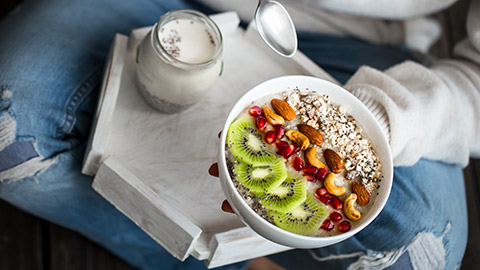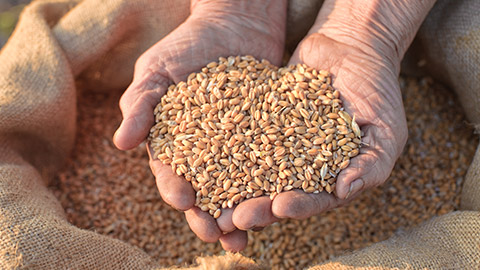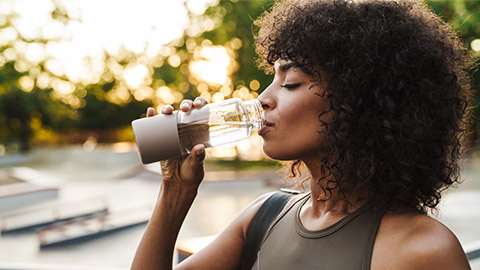To Keep the body in good health is a duty...otherwise we shall not be able to keep our mind strong and clearBuddah
Although the mind and body are viewed as separate, they could not be closer. In eSports, strong mental health may be linked to our body's health.
Eating a healthy diet and having regular physical activity are essential for all New Zealanders' overall health and well-being.
Diet, excess weight, physical inactivity, and alcohol use, along with the metabolic risk factors linked with them, continue to substantially contribute to ‘health loss’ among New Zealanders.
“In nutrition, diet refers to the food and drink that is regularly consumed by an individual (or a group).” A diet is a controlled consumption of food and drink for a particular purpose. For example a vegan diet only consists of whole plant foods and no animal products.
The term 'diet' has two meanings. It can mean the food and drink that is regularly consuded by an individual. For example, a person may have an omnivorous diet.
The other meaning is going on a diet. For example, a nutritionist or dietician has put a person on a diet.
The following are examples of specific diets.
- Carnivorous diet (diet comprised of meat)
- Omnivorous diet (diet comprised of both meat, seafood, eggs, dairy products, fruit and vegetables)
- Pescetarian diet (consisting of seafood instead of meat) but includes dairy products, fruit, vegetables and eggs.
- Vegan (diet consisting only of fruit, vegetables and legumes. No meat, dairy products or seafood)
- Ketogenic diet (diet with higher fat and low carbohydrates for the body to use fat as an energy source)
Not all diets are year-round. Some diets are for a short period of time to lose weight, gain weight, and prepare for an event. Many athletes go through this. Combat athletes preparing for a bout, basketball and American football athletes preparing for the season. The same can be said for esports athletes. Maintaining a healthy diet all year round is key to help optimise their performance. Esports athletes can also go on a stricter diet in preparation for an upcoming tournament. But what diet would an eSports athlete benefit from?

Vegetables, fruit, meat, and other foods provide vitamins, minerals, and dietary fibre.
Vitamins versus Minerals
- Vitamins: Organic and can be broken down by heat, air, or acid. Organic means it comes from plants or animals.
- Minerals: Inorganic and hold on to their chemical structure. Inorganic means it comes from soil or water. Together they are known as micronutrients.
Click on each of the following headings to learn more of what our bodies absorb from the food we consume.
- Carbohydrates
- Fat
- Protein
- Vitamin B complex
- Vitamin A
- Vitamin C
- Vitamin D
- Vitamin E
- Vitamin K
- Calcium
- Sulfur
- Phosphorus
- Iron
- Zinc
- Sodium
The importance of meal prepping
Meal prepping can not only help with organisation, but support adequate nutrition.
There are many different methods to meal prepping, but overall, there is a common trend: prepare meals or components of meals ahead of time.
You may choose to cook entire meals such as a baked chicken and pasta dish or black bean chilli, or you may simply prepare some components of meals such as stir-frying vegetables, baking tofu, and boiling grains or potatoes, then storing everything in large containers to mix and match throughout the week. You may also choose only to prep lunches for the week and leave dinners open for options.
Factors to consider when meal prepping
Here are some important factors to keep in mind when starting your meal-prepping journey.
- Schedule in shopping and cooking time into your week – you may choose to do online shopping so you can just swing by the supermarket on the way home.
- Have the right equipment – if you have minimal cooking equipment, search for “student friendly” meals/recipes.
- Find recipes suitable to your cooking skills – if this is the first time you cook for yourself and/or others, search for “beginner-friendly” recipes.
- Practice good food safety (clean aprons, clean up spills immediately after they occur, use a sharp knife with care- including washing, use caution, follow instructions when using an oven, and take care with hot pots and pans).
- Ensure you include a variety of foods throughout the weeks and months – stick to the Ministry of Health guidelines.
- Reach out to experienced home cooks or look up follow-along videos on YouTube for inspiration and guidance.
Choosing the right fruits and vegetables is easy. From seasonal fresh vegetables and fruits to canned and frozen options:
- When choosing canned fruit – look for options with low sugar and sodium (salt),
- Give it a go and try growing your own vegetables. This can encourage healthy eating and a sense of pride.
- Store vegetables and fruit carefully to keep their flavour, quality, and nutrient. Wash the vegetables before eating.
- When possible, wash rather than peel the skin of vegetables and fruits for the full nutrition held in the skin.
Serving sizes
According to the Ministry of Health, the following are the recommended serving sizes for fruit and vegetables.
Fruit
A standard serve of fruit is about 150 g (350 kJ),which is about the same as:
- 1 medium apple, banana, orange or pear
- 2 small apricots, kiwifruit or plums
- 1 cup diced or canned fruit (drained and with no added sugar), for example, pineapple, papaya
- 1 cup frozen fruit, such as mango and berries.
Vegetables
- ½ cup cooked vegetables (for example, pūhā, watercress, silverbeet, kamokamo (squash), carrot, broccoli, bok choy, cabbage or taro leaves)
- ½ cup canned vegetables (for example, beetroot, tomato, sweet corn)
- 1 cup green leafy or raw salad vegetables
- ½ medium potato or or similar sized piece of kūmara, taewa (Māori potato), yam (Pacific or NZ), taro, cassava, or green banana (technically a fruit)
- 1 medium tomato.

Grains are made into a variety of foods from rice to pasta to bread. Each type of grain holds its own nutritional value and can be consumed according to individual needs.
Wholegrain vs refined grains
Wholegrains contain the entire grain – which is made up of bran, germ, and endosperm. Refined grains have been milled (ground into flour or meal) in a way that removes the bran and germ. Wholegrains are naturally high in dietary fibre and provide energy (kilojoules), vitamins and minerals.
When choosing to eat grain, the healthier choice is to eat wholegrain:
- Wholegrain bread, wholegrain cereal, wholewheat biscuits, brown rice, wholemeal pasta.
- Meals are made from whole wheat flour, rye, and wheat flakes.
Eating wholegrain and high-fibre grain foods is linked with a lower risk of cardiovascular disease, type 2 diabetes, weight gain and some cancers, such as bowel cancer.
Grains are a staple to diets worldwide. They are generally affordable and easily available foods that give people some of the nutrients they need.
Some of the key characteristics of wholegrain food include the following:
- High in carbohydrates
- B vitamins
- Fibre
- Zinc
- Magnesium
Serving sizes
The following are examples of the recommended serving sizes for grains according to the Ministry of Health.
A standard serve (500 kJ) is about the same as:
- 1 slice (40 g) wholegrain bread
- ½ medium (40 g) wholegrain roll or flat bread
- ½ cup (75–120 g) cooked rice, pasta, noodles, barley, buckwheat, semolina, polenta, bulgur or quinoa
- ½ cup (120 g) cooked porridge
- ¼ cup (30 g) muesli
- 2 breakfast wheat biscuits
- 2/3 cup cereal flakes (wholegrain where possible)
- 3 (35 g) crispbreads or crackers (whole grain where possible).
Milk and milk products are highly nutritious and contain protein, vitamins and minerals. Specific vitamins include riboflavin, vitamins A, D and B12, while minerals include calcium, phosphorus, zinc and iodine.
- Ministry of Health recommends that adults choose low- and reduced-fat milk.
- Milk and cheese contribute saturated fat to the diet.
Non-Dairy milk alternatives
These days, there are many non-dairy milk alternatives available on the market to cater for different dietary requirements.
Some of these non-dairy milk alternatives include plant-based options such as soy, almond, coconut, and oat. Though they do not naturally contain calcium, many options are fortified; selecting calcium-fortified soy milk using brands such as Sanitarium, Vitasoy, or Pam’s is important. The non-dairy alternative that is closest to cow’s milk is soy, as it has a similar nutrient profile.
Fat content differs between lite, reduced-fat, homogenised, and full cream. Choosing milk and milk products should consist of low and reduced fat (green- yellow-label milk):
- If you are making the shift, start with reduced fat (light blue) as there won’t be large taste differences from homogenised (dark blue)
- When choosing milk or alternatives, choose plain options such as reduced fat light blue or trim milk, lite soy milk, and plain yoghurt. You can add fresh fruit into yoghurt for sweetness if you like – a good way to get in one of your fruit servings.
Serving sizes
A standard serve (500–600 kJ) is about the same as:
- 1 cup (250 ml) low or reduced fat fresh, UHT long life, reconstituted powdered milk or buttermilk
- 2 slices (40 g) or a 4 x 3 x 2 cm piece of cheese such as Edam
- ¾ cup (200 g) low- or reduced-fat yoghurt
- 1 cup (250 ml) calcium-fortified plant based milk alternatives (for example, soy, rice, almond, oat milk) (with at least 100 mg of added calcium per 100 ml).
The food group of Protein Legumes, Nuts, Seeds, Fish and other Seafood, Pigs, Poultry/ Red Meat is an important macronutrient our body. It is overpowered: it repairs, grows, and maintains our tissues. It's essentially the building block of our body. Some proteins in our body produce enzymes that help digestion, while others help transport oxygen through our bloodstream. You can find protein in meat, fish, eggs, beans, and nuts.
- Legumes, nuts and seeds are rich in nutrients and high in fibre and are a source of protein.
- Fish and seafood are good sources of iodine.
- Oily fish such as salmon, tuna, mackerel and sardines and some seafood like mussels are good sources of omega-3 fatty acids.
- Eggs provide useful nutrients.
- Poultry (eg, chicken) is a good source of protein and some minerals, including iron and zinc.
- Red meat is an excellent source of key nutrients like iron (in an easily absorbed form) and zinc.
Protein consumption and exercise
Most daily food intakes contain well above the recommended requirement for protein.
Filling up on protein in the pre-exercise window may reduce appetite because the body's preferred fuel for training is carbs. This may negatively impact exercise performance. A small amount of protein in the pre-event meal will help with satiety (fullness).
Post-training (or post-event) meals should include some protein. This can help to restore muscle glycogen levels, repair muscle tissue, and may help encourage gain in lean body mass. 20-30g of protein in a post-training meal is sufficient. There is little evidence to suggest that consuming more than 30g of protein in one sitting gives additional benefits unless the person carries large amounts of additional muscle mass.
Spreading your protein intake out throughout the day can help improve muscle protein synthesis and muscle growth and may be easier on the stomach.
Protein is an important macronutrient to help build muscle and many other structures throughout the body. We can get most of the protein we need throughout the day simply by considering our food choices. Protein supplements are unnecessary but can be helpful for those:
- in a calorie deficit
- that have very high protein needs for recovery and muscle growth
- that are vegan or vegetarian
- that are athletes and find it difficult to achieve protein requirements through food alone.
Serving sizes
According to the Ministry of Health for Legumes, nuts, seeds, fish and other seafood, eggs, poultry and/or red meat with fat removed, the following are examples of the recommended serving sizes.
- 1 cup (150 g) cooked or canned beans, lentils chickpeas, or split peas (preferably with no added salt)
- 170 g tofu
- 30 g nuts, seeds, peanut or almond butter or tahini or other nut or seed paste (no added salt)
- 100 g cooked fish fillet (about 115 g raw) or one small can of fish
- 2 large (2 x 60 g = 120 g) eggs
- 80 g cooked lean chicken (100 g raw)
- 65 g cooked lean meat such as beef, lamb, pork, veal (90–100 g raw) – no more than 500 g cooked (700–750 g) red meat each week.
(Ministry of Health, 2020)
A calorie is a unit of energy. In nutrition, calories refer to the energy people get from the food and drink they consume and the energy they use in physical activity. In New Zealand, we use Kilojoules (kJ) instead of kcal and cal. They are both measurements of food energy levels. When looking at calories or Kilojoules, the general conclusion is the more activity you do, the more energy you will require and vice versa. The less activity you do, the less energy you will require.
There are two types of calories:
- A small calorie (cal) is the amount of energy required to raise the temperature of 1 gram (g)
- A large calorie (kcal) is the amount of energy required to raise 1 kilogram (kg). It is also known as a kilocalorie.
1 kcal is equal to 1,000 cal.
A 250-calorie chocolate bar actually contains 250,000 calories.
The number of calories in food tells us how much potential energy they contain.
- 1 g of carbohydrates contains 4 kcal
- 1 g of protein contains 4 kcal
- 1 g of fat contains 9 kcal
It is important to consider however, the specific foods will provide you with a more sustainable source of energy and keep you fuller for longer. Food that is high in saturated fat and sugar (Fast Food, Mcdonald's KFC and doughnuts, crisps etc.) are very high in calories and will not keep you full for long enough. However, consuming foods rich in protein and healthy fats, such as fish, eggs, avocado, nuts, etc., will be more nutritious and keep you full.
Fun Fact!
Did you know, the quicker your food heats in a microwave the more calories your food has. For example, if you put some chicken nuggets in the microwave for 10 seconds and they were piping hot when you took them out, they have a high calorie content!
Have you ever felt like you don't want to do anything? Tired for no reason or just do not feel energetic even after sleeping? This may be caused by the lack of both vitamins and minerals! You see, our body not only needs to function it needs to produce substances for our own survival! And the only way to produce this through our organs is to stack them with both vitamins and minerals! These are referred to micronutrients. If protein, carbs, and fats are energy, vitamin-B, iron, zinc are the vitamins and minerals our body need to stay healthy. Humans only need these in small quantities.
The following are the properties of each vitamin and mineral.
- Vitamin A: Improves your immune system
- Vitamin B1 - B8: Converts carbs to glucose
- Vitamin B12: Healthy blood and nerve cells
- Vitamin K: Found in greens and fermented food, good blood coagulation
- Potassium: Activates nerve and cell functions
- Sodium: Conducts Nerves and impulses, helps balance of water and mineral
- Vitamin C: Healthy skin, protect cells, immune system boost
- Zinc: Thyroid function, wound healing, sense of smell.
- Magnesium: Improve sleep, treat migraines, boost mood
- Vitamin D: Weight loss related, bad cholesterol levels Calcium: Bones, cardiac benefits, balance PH
- Phosphorus: Reduce weakness, detox, boost digestion
- Vitamin B9: Prevents health issues from developing
- Vitamin E: Found in nut oils it helps prevent heart disease or cancer
- Iron: Stimulates energy, helps battle tiredness and fatigue
- Potassium: Helps the cells by creating the needed electricity to activate them

Water is essential to life. In most cases it is exactly what the body needs (paired with a healthy diet). Plain water contains zero energy and doesn’t contribute to weight gain.
You should aim to drink at least 2L of water daily. This amount is likely to increase depending on the level of physical activity, perspiration and hot climates. 75% of what you drink in a day ideally should be water.
Staying hydrated
The human body needs to stay hydrated in order to survive - when you are dehydrated your body (internally and externally) and mind weakens. You can hydrate with any liquid, but it is recommended to hydrate with water as it has the least negative effects on the body.
Water helps regulates the body temperature, lubricates the joints, helps remove waste, delivers nutrients to cells and keeps the internal organs functioning. Water calorie intake is zero. No sugar, no fats, and no carbohydrates.
Keeping hydrated is key to a functioning body. The following are a few tips to keep yourself hydrated through-out the day:
- Keep and carry a bottle of water with you. Set a goal to finish a set amount of water before you finish class or work before the end of the day. Water accountability bottles are great for keeping track of how much you are drinking.
- If you dislike the taste of water, try adding a slice of lemon or lime (you can substitute this with a water sweeter)
- Drink water on schedule, if you forget to drink throughout the day aim to drink water the same time you eat meals.
Dehydration is common for the human body when it doesn’t get enough fluids –the following are a few signs you may be dehydrated:
- Little to no urine
- Urine is darker than usual (the darker the more dehydrated the body is)
- Extreme thirst
- Dry lips
- Headache
Sports drinks with electrolytes is another liquid that helps the body hydrate. Common electrolytes include sodium, chloride, potassium, magnesium and calcium. These help the body in multiple ways. Sports drinks are best used before, during and after prolonged exercise. Sports drinks still include calories (carbs, fats, and protein) contributing to your daily intake.
Energy drinks are there for when you need a boost of energy! It isn’t the healthiest drink for the body as it contains a lot of sugar and other ingredients. If you tend to drink a lot of energy drinks, try to cut back to one a day or even better, one-three a week.

Caffeine is found all types of drinks such as black and green coffee, energy drinks, kombucha, some soft drinks and chocolate drinks. Remember, caffeine is fine, but in moderation. You should also be mindful that caffeine will impact sleep quality. Consider how much caffeine you consume, particularly in the afternoons, as this will likely impact how well you sleep at night.
The following table illustrates the amount of caffeine found in common drinks.
| Drinks | Amount Caffeine |
|---|---|
| Black Tea (250 ml | 25-48 mg |
| Cola (355 ml) | 30-40 mg |
| Green Tea (250 ml) | 15-30 mg |
| Drinking Chocolate (250ml) | 1-5 mg |
| Coffee (Cappuccino) (260 ml) | 63 mg |
| Energy Drink (250ml) | 70-100 mg |
| Plunger Coffee (250 ml) | 95 mg |
*these values are approximate averages and can vary depending on the specific brand, preparation method, and ingredients used.
Overweight and obesity are medical conditions characterized by excessive or abnormal accumulation of body fat, which may negatively affect a person's health. They are typically determined by body mass index (BMI), a calculation considering a person's weight and height.
Body Mass Index
BMI is an index that calculates weight in relation to height to give a BMI score. This BMI score indicates which body weight category a person belongs to.
BMI equation
Example – to calculate the BMI of someone who is 2.0 meters and weighs 88 kilograms.
Use the following equation:
First, calculate bodyweight/ height (Square).
To solve this equation correctly, you must first solve the equation in the brackets.
- 2 x 2 (Height squared) = 4
- 88 / 4 (Bodyweight/height squared) = 22
- 22 = Healthy weight
Overweight
Being overweight is generally defined as having a BMI between 25 and 29.9. It indicates that a person has a higher body weight in relation to their height than what is considered healthy or normal. It suggests excessive body fat but may not necessarily indicate obesity. However, being overweight can still pose health risks and may increase the likelihood of developing various medical conditions such as heart disease, type 2 diabetes, and certain types of cancer.
Obesity
Obesity is a more severe condition with a BMI of 30 or higher. It signifies a significant excess of body fat and increases health risks. Obesity is generally categorized into three classes:
- Class 1 obesity: BMI between 30 and 34.9
- Class 2 obesity: BMI between 35 and 39.9
- Class 3 obesity (also known as morbid obesity): BMI of 40 or higher
Obesity increases the risk of various health problems, including cardiovascular disease, stroke, type 2 diabetes, certain cancers, respiratory disorders, musculoskeletal issues, and mental health conditions.
It's important to note that while BMI is a commonly used measurement, it has limitations. It doesn't account for factors such as muscle mass, distribution of body fat, or overall body composition.
